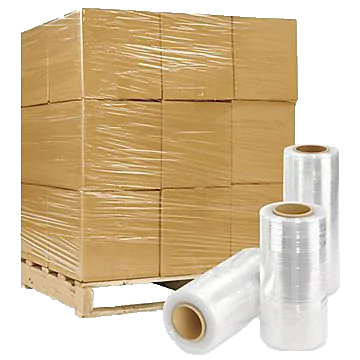- 24 Tech Roqad st Ny 10023
- Office Hour : 08:00am - 6:00pm

A thin yet durable plastic film serves to stabilize the load while shielding it from moisture and dirt. The objective of stretch wrapping is to tightly, neatly, and economically package the product. Our selection primarily features 500 mm wide film rolls, although alternative sizes are also available. Wrapping can be accomplished manually or with the assistance of a pallet wrapper, and our inventory encompasses stretch films available in both hand and machine rolls. Furthermore, we offer both blown and cast wrapping films.
Stretch film, sometimes referred to as stretch wrap or pallet wrap, is a highly elastic and flexible plastic film that is extensively utilised in the packaging sector. Usually constructed of polyethylene or a similar material, it is intended to tightly wrap around objects or pallets in order to secure, protect, and bundle them while in storage, transit, or shipping. When stretched, stretch film sticks to itself, sealing the things in a tight, conforming seal that firmly holds them together. It is a versatile and crucial packaging material for securing loads of various sizes and shapes in a variety of sectors because it provides benefits such load containment, protection from dust and moisture, tamper-evident security, and ease of handling.
Stretch film, commonly referred to as stretch wrap, is a self-adhesive plastic film that is highly elastic and used extensively in the packaging industry to secure and protect products on pallets or in individual bundles. During the wrapping process, strain is applied to the film, making it to stretch and tightly adhere to the shape of the goods or pallet. Stretched film sticks to itself as it is wrapped around the goods to form a strong and solid unit. Stretch film is made to keep its tension while offering load stability, tamper resistance, and defence against dust, moisture, and outside pollutants during transit and storage. It is a flexible and affordable option for packaging and palletizing products in a variety of sectors due to its ability to attach to surfaces without adhesive.
Stretch film, sometimes referred to as stretch wrap or stretch packaging film, has a number of crucial advantages for the packaging sector:
Stretch film is a versatile and important tool in the packaging business for bundling, safeguarding, and stabilising a variety of goods and loads because of these characteristics.
Stretch Film operation in the packaging sector is a simple procedure. The stretch film roll must first be put on a dispenser or wrapping machine securely. Place the item or pallet you plan to wrap next on a sturdy surface or conveyor. Start by fastening the stretch film to the item or pallet by pulling it across the top of the load. To begin the film’s rotation and apply stress as it wraps the package firmly, turn on the dispenser or wrapping machine. Once the product is completely wrapped and fastened, continue wrapping it both horizontally and vertically. To complete the wrapping procedure, cut the film with a tool or rip it. Keep safety considerations in mind, especially when operating machinery, and adhere to manufacturer recommendations for the best results.
Here are four important safety features:
Due to its many uses, stretch film, commonly known as stretch wrap or pallet wrap, plays a significant role in the packaging sector. It is mostly utilised to secure and bundle goods for storage and transit on pallets. Stretch film significantly lowers the danger of load damage by preventing products from shifting or dropping during transit. Additionally, it safeguards objects against tampering, moisture, and dust, preserving the integrity of the packaged goods. Stretch film can be used to wrap certain products or parcels, adding an extra degree of security and protection. For supply chain and packaging process optimisation, it is an essential tool in a variety of industries, including manufacturing, shipping, and retail due to its simplicity of use and low cost.
In order to keep stretch film in top condition, the packaging sector must first follow the right handling and storage procedures. Rolls of stretch film should be kept cold, dry, and clean to preserve their elasticity and function. Keep them away from harsh sunlight and high temperatures. To avoid tears and damage, handle the film with clean hands and steer clear of rough surfaces. Check the film frequently for any obvious flaws, such as tears or punctures, and replace any damaged rolls right away. To guarantee a seamless and effective application, keep wrapping tools and film dispensers clean and well-maintained. Stretch film is more successful at securing and protecting packaged goods when it is maintained properly, maintaining its quality and functionality.